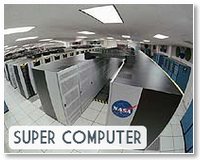 |
Warwick, UK (SPX) Nov 16, 2010 New research from the University of Warwick, to be presented at the World's largest supercomputing conference next week, pits China's new No. 1 supercomputer against alternative US designs. The work provides crucial new analysis that will benefit the battle plans of both sides, in an escalating war between two competing technologies. Professor Stephen Jarvis, Royal Society Industry Fellow at the University of Warwick's Department of Computer Science, will tell some of the 15,000 delegates in New Orleans next week, how general-purpose GPU (GPGPU) designs used in China's 2.5 Petaflops Tianhe-1A fare against alternative supercomputing designs employed in the US; these use relatively simpler processing cores brought together in parallel by highly-effective and scalable interconnects, as seen in the IBM BlueGene architectures. Professor Jarvis says that: "The 'Should I buy GPGPUs or BlueGene' debate ticks all the boxes for a good fight. No one is quite sure of the design that is going to get us to Exascale computing, the next milestone in 21st-century computing, one quintillion floating-point operations per second (10^18). "It's not simply an architectural decision either - you could run a small town on the power required to run one of these supercomputers and even if you plump for a design and power the thing up, programming it is currently impossible." Professor Jarvis' research uses mathematical models, benchmarking and simulation to determine the likely performance of these future computing designs at scale: "At Supercomputing in New Orleans we directly compare GPGPU designs with that of the BlueGene. If you are investing billions of Dollars or Yuan in supercomputing programmes, then it is worth standing back and calculating what designs might realistically get you to Exascale, and once you have that design, mitigating for the known risks - power, resilience and programmability." Professor Jarvis' paper uses mathematical modeling to highlight some of the biggest challenges in the supercomputing war. The first of these is a massive programming/engineering gap, where even the best computer programmers are struggling to use even a small fraction of the computing power that the latest supercomputing designs have and, which will continue to be a problem without significant innovation. Professor Jarvis says: "If your application fits, then GPGPU solutions will outgun BlueGene designs on peak performance" - but he also illustrates potential pitfalls in this approach - "the Tianhe-1A has a theoretical peak performance of 4.7 Petaflops, yet our best programming code-based measures can only deliver 2.5 Petaflops of that peak, that's a lot of unused computer that you are powering. Contrast this with the Dawn BlueGene/P at Lawrence Livermore National Laboratory in the US, it's a small machine at 0.5 Petaflops peak [performance], but it delivers 0.415 Petaflops of that peak. In many ways this is not surprising, as our current programming models are designed around CPUs." But the story doesn't end there. "The BlueGene design is not without its own problems. In our paper we show that BlueGenes can require many more processing elements than a GPU-based system to do the same work. Many of our scientific algorithms - the recipes for doing the calculations - just do not scale to this degree, so unless we invest in this area we are just going to end up with fantastic machines that we can not use." Another key problem identified by the University of Warwick research is the fact that in the rush to use excitingly powerful GPGPUs, researchers have not yet put sufficient energy into devising the best technologies to actually link them together in parallel at massive scales. Professor Jarvis' modeling found that small GPU-based systems solved problems between 3 and 7 times faster than traditional CPU-based designs. However he also found that as you increased the number of processing elements linked together, the performance of the GPU-based systems improved at a much slower rate than the BlueGene-style machines. Professor Jarvis concludes that: "Given the crossroads at which supercomputing stands, and the national pride at stake in achieving Exascale, this design battle will continue to be hotly contested. It will also need the best modelling techniques that the community can provide to discern good design from bad." The paper, to be presented on the 15th of November, is entitled 'Performance Analysis of a Hybrid MPI/CUDA Implementation of the NAS-LU Benchmark' and is by S.J. Pennycook, S.D. Hammond, G.R. Mudalige and S.A. Jarvis (all of whom were at the University of Warwick's Department of Computer Science when this work was undertaken). The paper will be presented in the technical track of SC 10, at the Workshop on Performance Modeling, Benchmarking and Simulation of High Performance Computing Systems (PMBS 10).
Share This Article With Planet Earth
Related Links University of Warwick Super Computer News and HPC Technology
 Chinese supercomputer named world's fastest
Chinese supercomputer named world's fastestBeijing (AFP) Nov 15, 2010 China overtook the United States at the head of the world of supercomputing on Sunday when a survey ranked one of its machines the fastest on the planet. Tianhe-1, meaning Milky Way, achieved a computing speed of 2,570 trillion calculations per second, earning it the number one spot in the Top 500 (www.top500.org) survey of supercomputers. The Jaguar computer at a US government facility ... read more |
|
| The content herein, unless otherwise known to be public domain, are Copyright 1995-2010 - SpaceDaily. AFP and UPI Wire Stories are copyright Agence France-Presse and United Press International. ESA Portal Reports are copyright European Space Agency. All NASA sourced material is public domain. Additional copyrights may apply in whole or part to other bona fide parties. Advertising does not imply endorsement,agreement or approval of any opinions, statements or information provided by SpaceDaily on any Web page published or hosted by SpaceDaily. Privacy Statement |